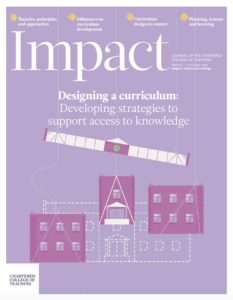English and maths GCSE resits in general further education colleges: Can employer-sponsored curricula improve student engagement and motivation?

- Collaboration |
- Cross-Curricular |
- English |
- Exams |
- Maths |
- Motivation
Writing about curriculum development in 1975, Lawrence Stenhouse (Stenhouse, 1975) noted that the task of educational institutions is to make ‘available to the young a selection of society’s intellectual, emotional and technical capital’. Educators must introduce students to a series of ‘public traditions’, including knowledge, skills, attitudes and behaviours. Nearly 50 years later, Stenhouse’s words feel particularly apt for anyone approaching curriculum design in further education (FE), where we have a responsibility to prepare students for employment and for adult life.
Within FE colleges, we develop ‘study programmes’, which combine qualifications with additional elements, such as work experience and enrichment activities. One area in which colleges face a particular challenge is in the delivery of GCSE English and maths resits, which have been a requirement since 2013. Teachers are often faced with the challenge of motivating disaffected students keen to leave the more academic elements of their education behind them.
With Stenhouse’s stipulation in mind, we wanted to explore the effect that a holistic approach to curriculum design might have on student engagement and achievement in English and maths. To do this, we worked with employers and vocational tutors to design cross-curricular projects, which primarily aimed to:
- enhance student motivation by linking English and maths directly to the world of work and to broader social contexts
- develop student literacy and numeracy
- improve student knowledge of and confidence concerning the world of work.
Research contexts
FE colleges face numerous challenges when delivering English and maths GCSE resit courses, including high numbers of students with special educational needs, with English as an additional language, with emotional and behavioural barriers to learning, and with challenging socio-economic circumstances (Higton et al., 2017). There is no single solution to boosting success rates in these subjects, but through the adoption of a holistic approach to curriculum design, of the kind advocated by Stenhouse, we aim to support student achievement while improving their day-to-day experience of both subjects.
Research into maths and English provision in FE indicates that motivation is a prime concern when addressing achievement rates, and there is evidence that both motivation and achievement can be enhanced by the contextualisation of knowledge and skills, with reference to, for example, the career choices students have made (EEF, 2016). There is additional evidence from Yeager et al. (Yeager et al., 2014) that in some contexts motivation can be boosted if students are encouraged to think beyond their own career plans. This ‘self-transcendent’ form of motivation is derived from a much broader form of contextualisation, based on linking courses and career aspirations to their higher social purpose and relevance.
In their theory of situated learning, Lave and Wenger (Lave and Wenger, 1991) highlight the extent to which all learning involves a degree of participation in ‘communities of practitioners’ and they argue that mastery in an area requires moving towards ‘full participation in the sociocultural practices of a community’. Employer engagement in the curriculum makes it possible to bring students closer to full participation in the workplace in terms of their knowledge, skills, attitudes and behaviour.
Methods
In our work with employers to develop projects for students resitting English and maths GCSE, we focused on two main areas:
- the design and delivery of the projects themselves
- the assessment of the efficacy of these projects in achieving the aims outlined above.
Tutors developed a series of employer-sponsored, cross-curricular projects for students studying maths and/or English alongside level 1, 2 and 3 courses in construction, plumbing, carpentry, painting and decorating, brickwork, motor vehicle maintenance, IT and engineering. Our collaborators included representatives of Beard Construction, BMW MINI, Peter Brett Associates (PBA), RES (Renewable Energy Systems) and Lee and Freeman Painting and Decorating Contractors. All of these projects included:
- ‘real world’ challenges that organisations are grappling with
- company resources and also project guides developed in partnership with employers
- an employer-led launch event
- ongoing mentoring by employers
- a grand finale where students were required to showcase their knowledge and skills.
Case study 1: Peter Brett Associates
Civil engineering firm PBA asked students to identify a location in Oxfordshire for the development of 2,000 new houses. The topic tapped into students’ local knowledge and encouraged them to think about broader social issues such as the UK housing crisis and environmental concerns. There were two iterations of this project:
- In 2016/17, 37 students worked on the project for 12 weeks (two lessons per week) and this was the only form of instruction they received for Cambridge iGCSE English (0522) during that period
- In 2017/18, 25 students worked on the project for one lesson a week for eight weeks and also undertook two ‘regular’ English lessons a week, linked to AQA GCSE English language (8700).
Case study 2: RES
The renewable energy developer RES put together a project on the Triton Knoll wind farm development off the north-east coast of England. The maths element of the project tasked students with examining the power output and project economics of an offshore wind farm. The English project asked students to write a response to a public consultation on the development of a new wind farm from the perspective of an interest group.
- For 10 weeks, 18 students took part in the maths and English projects as part of their timetabled GCSE lessons. These were linked to the AQA English language (8700) GCSE course and also to the AQA maths (8300F) GCSE course.
Evaluation
We measured changing student attitudes towards maths and English using questionnaires. For the first iteration of the PBA project we used a questionnaire developed internally, but for all other projects we used one developed with the Behavioural Insights Team, which allowed us to compare the responses of an intervention group (students within the technology faculty) with a control group (students in the A-level and business faculty). This questionnaire, based on Yeager’s self-transcendence scale, the Career Decision-Making Self-Efficacy Scale (CDMSE) and the Behavioural Identification Form (BIF), was designed to assess whether the projects made students feel more motivated to study maths and English; whether the projects had an effect on student understanding of and confidence relating to the world of work; and whether they helped develop attitudes and behaviours that would assist students in their careers. We also looked at student attendance and at GCSE exam results (mock and actual).
Preliminary findings
Students in the intervention group reported an improvement in their levels of motivation and in their attitudes towards learning. They were also more likely to report wanting to learn things that would help them have a positive impact on the world and to report feeling confident that they could work towards their goals even when they got frustrated. There was also a boost in their understanding of the meaningfulness of classroom activities (i.e. they were more likely to say that making changes to a piece of work involved learning how to improve their writing, rather than doing what their teacher told them). However, students in both the intervention and the control groups were less likely to say that achieving a grade C/4 would help them get a job and they reported a lower level of confidence when it came to choosing a career or path of further study.
Discussion
A total of 122 students were given questionnaires. We received a total of 45 matched pairs of responses, 31 from the treatment group and 14 from the control group. These did not yield statistically significant results, and, given the nature of the project – specifically the number of different teachers involved and the diversityThe recognition of individual differences in terms of race, ethnicity, gender, sexual orientation, socio-economic status, physical ability, religious beliefs and other differences in the cohorts of students – it is very difficult to attribute causation directly to the employer projects. However, we wanted to explore indicative results, and several areas of interest came to light.
Students in both the intervention and control groups reported an increase in confidence when talking to employers but the increase was greater for those in the control group. It is possible that, for students in the intervention group, their experience of engaging with employers recalibrated their perceptions of their own abilities in this area. One of the aims of the project was to enable students to make connection between maths and English and their future careers on the basis that this has been shown to boost motivation (Komarraju, 2013). Students in both groups reported a drop in confidence that English and maths would help with future employment. Many students obtained part-time employment during their time with us, meaning that in their eyes they had secured work without these qualifications.
While we may not have boosted motivation by highlighting the relevance of English and maths skills to future employment, it seems that we may have succeeded in boosting student motivation in a different, and arguably more important, way. The increase in students saying that they wanted to have a positive impact on the world is of interest because studies on motivation conducted by Yeager et al. (2014) indicate that while self-oriented and extrinsic motivations (such as career aims) did not predict student persistence in ‘boring’ tasks, self-transcendent motivations did. It is possible that the increase in resilience reported by the students can be linked to this. Furthermore, the recognition of the meaningfulness of schoolwork was correlated with self-transcendence (Yeager et al., 2014; (Betz et al., 1996). So, while students may be less secure in the idea that English and maths will lead directly to a job, they do communicate a better understanding that both subjects support their ability to effect a positive impact on the world.
With regard to future iterations of these projects, we need to employ different ways of facilitating interactions between students and employers and to find more creative ways to support students in making links between English, maths and employment. It may prove useful to engage students in an explicit exploration of the tensions between the curriculum knowledge they encounter in English lessons and the uses of English they encounter elsewhere. As Orr (Orr, 2018) has argued in relation to vocational knowledge, such tensions can themselves lead to ‘purposeful learning’.
Conclusions
Within a framework outlined by Stenhouse, emphasising the integration of knowledge, skills, attributes and behaviours, we sought to design and test a model of the curriculum that took emotional development as seriously as the fostering of disciplinary knowledge and technical skills. It is our belief that curriculum design should look outwards, making links with and contributing to local and regional skills ecosystems with a view to developing the kind of ‘public social partnerships’ envisioned by Hodgson and Spours (Hodgson and Spours, 2015). Ultimately, we aim to support our students to become knowledgeable and active citizens with the intellectual, technical and emotional capital they need to become confident agents within the world beyond that of education. The first step in this journey is to develop a system in which the gaps between education and the world of work are narrowed, thereby smoothing the transition between the two.
References
This article was published in September 2018 and reflects the terminology and understanding of research and evidence in use at the time. Some terms and conclusions may no longer align with current standards. We encourage readers to approach the content with an understanding of this context.










